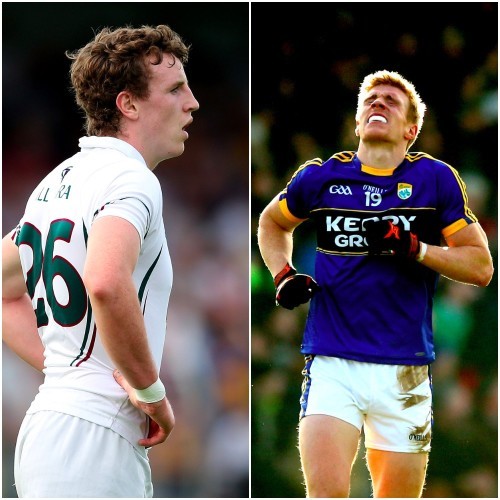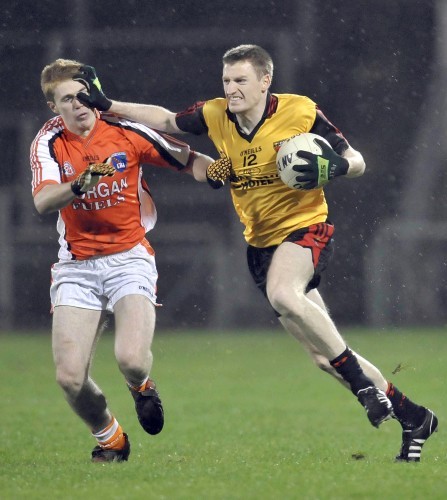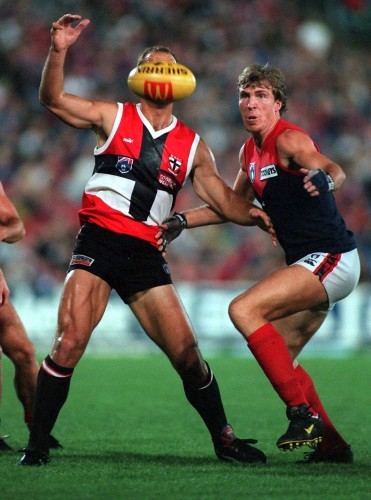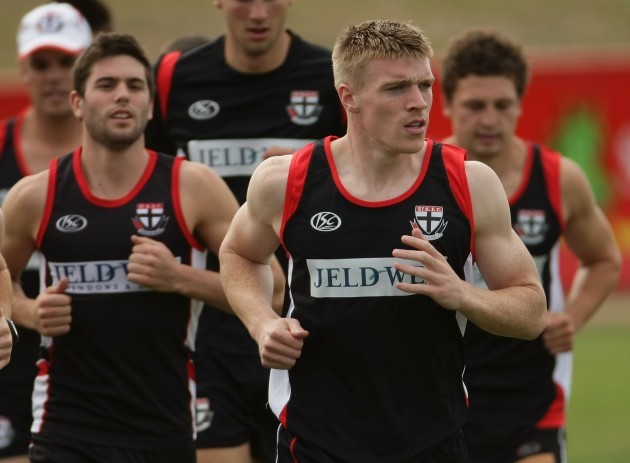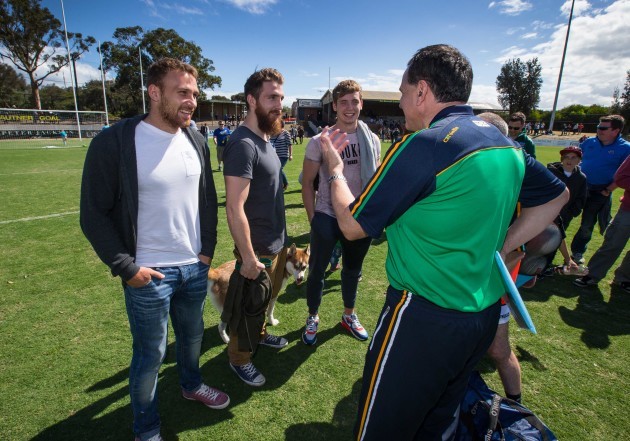WHEN SEAN HURLEY returned from Australia last year, his intentions were clear – get back into the Kildare jersey and start enjoying his sport again.
He’d endured a frustrating couple of years attempting to forge a professional career in Australia with Aussie Rules club Freemantle Dockers, before he was delisted six months ago.
But readjusting to Gaelic football hasn’t been a straightforward process for player who led the Lilywhites to Leinster U21 glory in 2013. Hurley quietly departed the Kildare panel this week, citing his inability to stay injury-free as the primary reason.
“Sean has had a tough few years with various injuries, particularly in Australia during his time with Fremantle,” Kildare boss Cian O’Neill said this week.
“His most recent hip surgery, and all the difficulties that are part of a rehabilitation programme following such a serious injury, have taken their toll on Sean and his body so the priority now has to be his basic health and functionality.”
He featured in all but two of Kildare’s 12 competitive games in 2014 before jetting Down Under to join Freemantle. But Hurley suffered two injury-ravaged years in Australia and has been unable to return to full fitness ever since.
What happened? After a solid first year with the club’s reserve team Peel Thunder, Hurley’s injury woes appeared to start after the hip surgery he underwent in the 2016 pre-season.
He managed just three games last year for the Thunder before Freemantle delisted him on 30 August.
“Sean came back injured,” Kildare coach Ronan Sweeney revealed last November. ”He went back over to get a little bit of surgery with them because they know the ins and outs of the operation.”
Hurley underwent further surgery on his hip in November in Australia, but his injury problems persisted as he attempted to resurrect his inter-county career.
“It was a case of my body screaming at me over a period of time, with my knees, quads, Achilles tendon, and hips all giving me trouble,” Hurley said about his fitness struggles last week.
Hurley is not alone.
Injuries are a worryingly common occurrence for GAA players who make the leap to the AFL. Making the transition from an amateur game to a professional one is extremely taxing on the body.
While a number of Irish players like Zach Tuohy and Pearce Hanley have enjoyed relatively healthy careers, other converts have struggled to stay fit.
Former Down U21 star Jamie O’Reilly is one of the lesser-known Gaelic footballers to switch codes.
A pacey, direct forward, he won Ulster U21 titles with Down in 2008 and 2009 before he chased the professional dream with AFL club Richmond in October 2009.
Remarkably, he featured in three AFL games in his first season in Australia, before injuries severely hampered his second campaign at the Melbourne club.
He picked up a stress fracture in his shin before later suffering strained medial ligaments in his knee.
Looking back, O’Reilly feels the extra work he was doing to get up to speed with a new sport contributed to his body breaking down.
“I think definitely there is a sort of trend there where you’re working that hard to get up to the standard,” he tells The42. “You get playing and especially when you get to the level of playing a few AFL games the intensity is just insane.
“The stress fracture was too much load. It wasn’t even so much the club specific stuff, I was just that eager to please I was doing bits and pieces extra myself, whether it was a wee weights session or an extra pitch session to improve the ball handling or kicking skills.
“It was just a gradual increase in load that caused the injury – that’s what stress fractures are.
“In terms of the medial ligament damage I did to the knee, it was purely just an accident in a game where I had tackled someone. Someone else came in third party, just wiped me out from the knees and I just strained it.”
O’Reilly made just one appearance in his second season at Richmond before he called a halt to his professional dreams in 2011. For the 23-year-old, the threat of a serious injury causing an immediate end to his career influenced his decision to return home in 2011.
“The way I looked at it was that the AFL had the potential to make me money for ten years, at the absolute maximum. My degree, which I had already invested three years into, was going to set me up in a career for life,” he said shortly after his return.
“There are plenty of cautionary tales out there of people who packed in university to be professional sportsmen, and then it didn’t work out for them.
“There’s no telling when you might pop a knee or pick up an injury, and suddenly you’re finished and you’re left with absolutely nothing.”
As one of just 19 Irish players who’ve logged minutes in an AFL Premiership game, O’Reilly is well placed to speak about the impact playing Aussie Rules can have on the body of a converted GAA player.
“Personally I found although you were training or in the gym everyday at home, it wouldn’t have been anywhere near the intensity of playing out there.
“Especially in the pre-season period you would have been doing an awful lot – maybe a two-hour pitch session and you were doing it in intense heat.
“Even stuff like, over here between drills you’d have three or four minutes to take a sip of water and have a chit chat. Over there it was very military. You ran flat out over to the drinks station to get a drink and you ran flat out to the next drill.”
Although there are striking similarities between both sports, O’Reilly says there are significant differences too.
“There’s a lot of differences that people don’t acknowledge much, which are probably taking their toll,” he continues. “Even down to the basic things like the size of the pitch, the length of the game and the clock stopping in the game. Those are things people don’t consider as much.
“The clock is stopping, the pitch is twice as big and the game is twice as long. So it’s a lot more impact and a lot more load you’re taking on than you’re used to doing if you’re playing a Gaelic game, even if it is at senior inter-county level.
“I think the average amount of time the ball is in play in a Gaelic match with the clock still running is 17 or 18 minutes a half, whereas in AFL you’re basically playing the four quarters of 20 minutes.
“It’s still 80 minutes so that’s a serious difference from maybe 35 minutes of the ball being in play in a Gaelic game.
“I would say it’s a gradual wear and tear thing where you’re doing that much extra over a period of time. There probably is a fatigue that sets it.”
O’Reilly also points out a league-wide culture, where it’s extremely common for players to go under the knife in the off-season after a gruelling campaign.
“That’s even an issue for guys who have grown up playing AFL too, where at the end of the season everybody is the walking wounded,” he says.
“You’re really dying for that end of season break to come. One thing I noticed an awful lot, and maybe it was because it’s professional and more controlled, but as soon as the end of season came and people had crawled over the finish line, players were going in for surgery left, right and centre.
“Some of it more serious that others but boys were getting hip surgeries and finger surgeries and shoulder reconstructions and all that kind stuff. There’s quite a bit of that.”
Tommy Walsh was one of the unfortunate ones. There was much hype surrounding his return to Kerry at the end of the 2014 season, but he hasn’t hit anywhere near the sort of form he was showing before his departure to St Kilda in 2009.
“The same Tommy that left for Australia in 2009 did not come home,” Tomas Ó Sé wrote last April.
Walsh joined the Sydney Swans in 2011 but played just five senior games for the club as injuries stalled his career. A devastating hamstring injury in 2013, where he tore all three tendons at the top of his hamstring off the bone, sidelined him for 12 months. Walsh never looked the same player again.
A host of the current crop in Oz have been struggling to log minutes on the field.
Carlton Blues half-back Ciaran Sheehan, an All-Ireland winner with Cork in 2010, has been hit hard by injuries, battling hip and groin problems in 2015 before suffering hamstring and knee injuries last year.
Louth’s Ciaran Byrne spent most of the 2015 campaign out with various injury problems and then tore his anterior cruciate ligament while in action for Carlton last July.
Cian Hanley, who joined the Brisbane Lions in 2015 while recovering from a torn cruciate he suffered in Ireland, spent all of 2016 on the sidelines with a groin issue.
Former Kildare prospect Paddy Brophy had his 2016 campaign ended last August with a persistent shoulder injury. He underwent an operation on his shoulder in the off-season.
Recent Sydney Swans recruit Colin O’Riordan made his first senior appearance for the club last week, but he hasn’t been without his injury woes either. The Tipperary native sustained a broken bone in his back and a punctured lung in a game for the Swans’ reserves back in August.
O’Reilly returned to finish his Business Management degree at Queen’s University, and while he went back playing club football with Loughisland, his time in Australia took its toll.
“My issue when I got home was I got straight back into university and I wasn’t training anywhere near as regimented as I should have been. Then my body started breaking down in bits and pieces due to that.
“Afterwards my body was a wee bit beat up from it for a couple of years. It did recover eventually, but it was more so while you’re out there and playing a lot of games I think the damage really happens for boys. Just because it’s so intense.”
The42 is on Instagram! Tap the button below on your phone to follow us!
